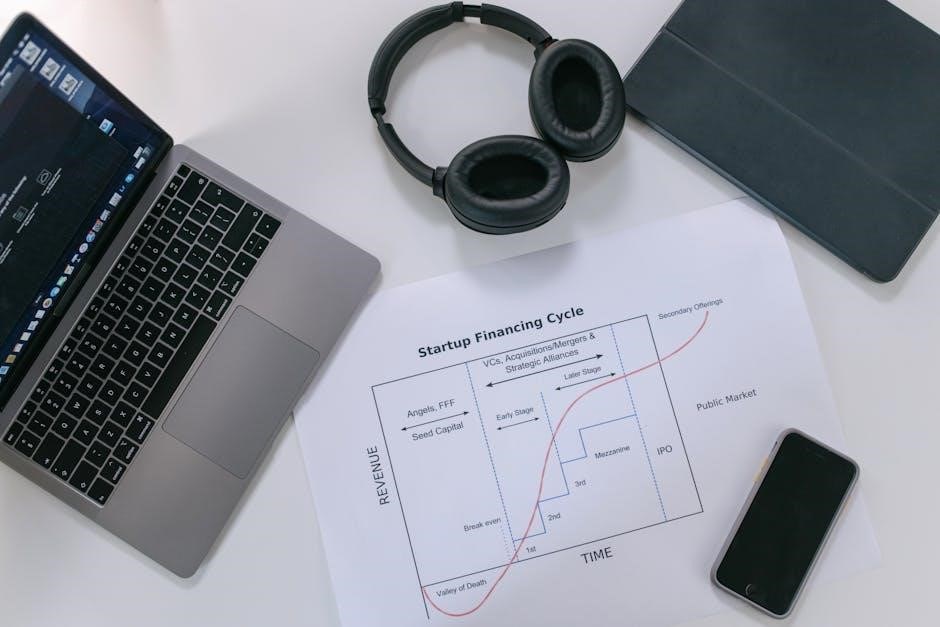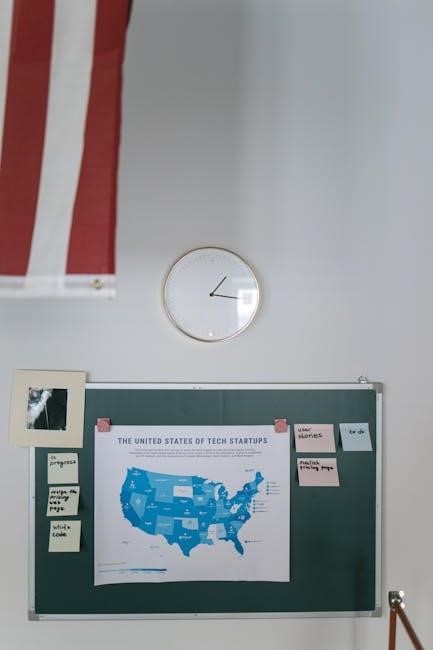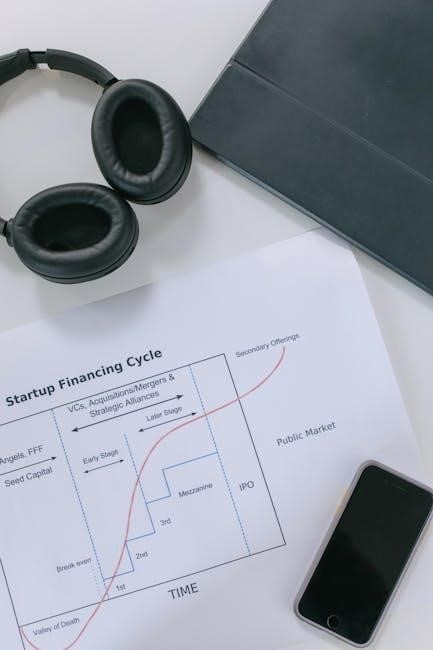Technical communication is the art of conveying complex information clearly and effectively. It plays a vital role in ensuring understanding and collaboration across various fields and industries.
1.1 Definition and Importance
Technical communication is the process of conveying complex information clearly and effectively to specific audiences. It is essential for collaboration, problem-solving, and decision-making in various fields. This guide emphasizes its importance in business operations, documentation, and user understanding. By bridging technical expertise with audience needs, effective technical communication ensures clarity, accuracy, and engagement, making it a cornerstone of professional success in both traditional and digital environments.
1.2 Evolution in the Digital Age
Technical communication has evolved significantly with the rise of digital platforms, shifting from traditional methods to electronic formats like websites and digital documents. This transformation emphasizes concise and clear writing, integrating multimedia elements for enhanced understanding. The digital age demands adaptability, with strategies like front-loading key information and using active voice becoming essential. These changes ensure technical communication remains effective in fast-paced, tech-driven environments, bridging the gap between innovation and audience comprehension.

Key Principles of Effective Technical Communication
Effective technical communication relies on clarity, conciseness, and an audience-centered approach. It involves organizing information logically and using visual aids to enhance understanding and engagement.
2.1 Clarity and Conciseness
Clarity and conciseness are cornerstone principles of effective technical communication. Avoiding unnecessary jargon and ensuring messages are direct and straightforward enhances readability. Using active voice and precise language helps convey complex ideas with simplicity. This approach ensures that the audience grasps the information quickly, fostering better understanding and decision-making. By prioritizing clarity, technical communicators can bridge gaps between expertise and accessibility, making information usable for diverse audiences.
2.2 Audience-Centered Approach
An audience-centered approach tailors communication to the needs, preferences, and expertise of the intended audience. Understanding who will receive the information ensures clarity and relevance. This method emphasizes empathy, focusing on what the audience values and how they process information. By aligning content with audience expectations, technical communicators create engaging and effective messages. This approach fosters clear understanding and ensures the information meets the audience’s goals, making communication more impactful and meaningful.
2.3 Contextual Relevance

Contextual relevance ensures that information is tailored to the specific situation, audience, and purpose. It involves understanding the setting in which communication occurs and adapting content accordingly. By focusing on the most pertinent details and avoiding unnecessary information, technical communicators enhance clarity and engagement. Contextual relevance also ensures that the message aligns with the audience’s needs, making it more impactful and effective in achieving its intended goal.

Best Practices for Technical Communication
Best practices include using active voice, organizing information logically, and incorporating visuals to enhance clarity and engagement while addressing the audience’s specific needs concisely.
3.1 Using Active Voice
Using active voice enhances clarity and directness in technical communication. It makes sentences more engaging and easier to understand, reducing ambiguity. Active voice is particularly effective in instructions, reports, and documentation, as it clearly identifies the subject performing the action. For example, “The team conducted the analysis” is more straightforward than “The analysis was conducted by the team.” This approach ensures messages are conveyed efficiently, aligning with the principles of concise and audience-centered communication.
3.2 Organizing Information Logically
Organizing information logically is crucial for effective technical communication. A clear structure ensures readability and helps the audience follow complex ideas effortlessly. Use headings, subheadings, and bullet points to break down content, making it visually accessible. Apply the inverted pyramid method by placing key information first, followed by supporting details. Consistency in formatting and terminology enhances professionalism and clarity, ensuring the message is conveyed efficiently and without confusion.
3.3 Incorporating Visual Aids
Incorporating visual aids like images, diagrams, and charts enhances technical communication by making complex information more accessible. Videos and infographics can also engage audiences effectively. These elements should be relevant, well-designed, and placed strategically to support the text without overwhelming it. Visuals help break down intricate concepts, ensuring clarity and improving comprehension. The guide emphasizes using visuals judiciously to reinforce key points and maintain a balanced, professional presentation.

Strategies for Effective Technical Communication
Effective technical communication relies on clear, concise strategies and proven methods to convey information. This guide emphasizes organizing content logically, using active voice, and addressing audience needs precisely.
4.1 Front-Loading Key Information
Front-loading key information is a strategic approach where the most critical details are presented at the beginning. This method ensures immediate clarity, saving time for both the communicator and the audience. By prioritizing essential content upfront, technical communication becomes more efficient and impactful. This technique is particularly useful in documents, presentations, and reports, as it helps readers quickly grasp the main points without wading through unnecessary details.
4.2 Applying Rhetorical Approaches
Applying rhetorical approaches in technical communication involves tailoring messages to the audience, purpose, and context. This method emphasizes understanding the audience’s needs, preferences, and background to convey information persuasively and clearly. By focusing on ethos, pathos, and logos, communicators can build credibility, evoke the desired response, and ensure logical clarity. Rhetorical strategies help technical communicators adapt their tone, style, and content to achieve their goals effectively in diverse situations.
4.3 Conducting Audience Analysis

Conducting audience analysis is crucial for effective technical communication. It involves understanding the audience’s technical expertise, preferences, and cultural background to tailor the message. By analyzing their needs and expectations, communicators can structure information logically and use appropriate language. This ensures clarity, relevance, and engagement. Audience analysis also helps in selecting the right medium and tone, making the communication more impactful and aligned with the audience’s understanding level.
Tools and Resources for Technical Communication
Traditional writing tools, modern digital platforms, and collaboration software are essential for effective technical communication. These resources enable clear, professional, and efficient content creation.
5.1 Traditional Writing Tools
Traditional writing tools remain foundational for technical communication. Style guides like AP, Chicago, and MLA ensure consistency. Dictionaries and thesauruses aid precise language. Reference books and print manuals provide established frameworks. These tools emphasize clarity and accuracy, helping communicators refine their writing. They are indispensable for drafting clear, professional, and well-structured documents, ensuring messages are conveyed effectively.

5.2 Modern Digital Tools
Modern digital tools have revolutionized technical communication, enabling efficiency and collaboration. Grammarly and Hemingway Editor enhance clarity and conciseness. Collaboration platforms like Slack and Microsoft Teams facilitate real-time feedback. Version control systems such as GitHub manage document revisions. These tools streamline workflows, improve writing quality, and ensure consistent communication across teams. They are essential for meeting the demands of today’s fast-paced, tech-driven environment.
5.3 Collaboration Software
Collaboration software enhances teamwork in technical communication by enabling real-time document sharing and feedback. Tools like Slack and Microsoft Teams facilitate seamless communication, while Google Workspace and Notion support collaborative editing. These platforms streamline workflows, improve document version control, and ensure consistency. They are indispensable for remote teams, fostering productivity and alignment in creating high-quality technical content.
Challenges in Technical Communication
Technical communication faces challenges like simplifying complexity, managing jargon, and ensuring clarity without losing essential details, requiring a balance between simplicity and precision.
6.1 Simplifying Complex Information
Simplifying complex information is a cornerstone of effective technical communication. It involves breaking down intricate concepts into clear, digestible parts without losing essential details. Using plain language, avoiding jargon, and organizing content logically are key strategies. Techniques like the inverted pyramid method and bullet points enhance readability. This approach ensures that even highly technical material is accessible to diverse audiences, fostering understanding and collaboration. Clarity and precision are balanced to maintain accuracy while making information user-friendly.

6.2 Managing Jargon and Terminology
Managing jargon and terminology is essential in technical communication to ensure clarity and accessibility. While specialized terms are often necessary, overuse can alienate audiences. Communicators must strike a balance by defining jargon clearly and using it sparingly. Understanding the audience’s familiarity with the subject matter helps tailor language appropriately. Providing context or a glossary can also bridge gaps. Effective management of terminology ensures that complex ideas are conveyed accurately without hindering comprehension, making communication more inclusive and effective for diverse readers.
6.3 Addressing Cultural and Language Barriers
Addressing cultural and language barriers is crucial for effective technical communication. Communicators must consider the audience’s cultural background and language proficiency. Simplifying content, avoiding idioms, and using clear, universal language helps bridge gaps. Visual aids and consistent terminology further enhance understanding. Being sensitive to cultural nuances ensures that messages are conveyed respectfully and accurately. By adapting communication strategies to diverse audiences, technical communicators can foster inclusivity and ensure that information is accessible and comprehensible across linguistic and cultural divides.

The Role of Visual Aids in Technical Communication
Visual aids enhance understanding by presenting complex information in an engaging and accessible format, making technical content more digestible and memorable for diverse audiences.
7.1 Using Images and Videos Effectively
Images and videos are powerful tools in technical communication, making complex information accessible and engaging. They break down text-heavy content, enhance understanding, and improve retention. When placed strategically, visuals draw attention to key points, facilitating faster comprehension. Videos, in particular, excel at demonstrating processes or concepts, while images like diagrams or charts clarify data. Effective use of visuals ensures content is not only informative but also visually appealing, making it more shareable and impactful for diverse audiences.
7.2 Designing Clear and Purposeful Visuals
Designing clear and purposeful visuals is essential for effective technical communication. Avoid clutter by focusing on simplicity and relevance. Use consistent colors, labels, and fonts to maintain clarity. Ensure visuals are placed where they add the most value and directly support the text. Align images and videos with the content’s purpose to enhance understanding. Clear visuals communicate complex ideas efficiently, making them indispensable in technical documentation and presentations.

Ethical Considerations in Technical Communication
Ethical technical communication demands honesty, accuracy, and respect for intellectual property. Communicators must ensure information is truthful, properly cited, and free from bias or misinformation.
8.1 Ensuring Accuracy and Truthfulness
Accuracy and truthfulness are cornerstone principles in technical communication. Communicators must verify facts, data, and sources to avoid misinformation. Clear attribution of borrowed content ensures intellectual honesty. Avoiding bias and presenting balanced perspectives fosters trust. Inaccuracies can undermine credibility and lead to misinterpretation. Therefore, meticulous research and transparent communication are essential to maintain ethical standards and ensure the reliability of technical information.
8.2 Respecting Intellectual Property
Respecting intellectual property is crucial in technical communication. Proper citation of sources, obtaining permissions for copyrighted material, and avoiding plagiarism are essential. Use original content or ensure fair use guidelines are followed. Always credit creators and adhere to licensing terms. This not only maintains ethical standards but also prevents legal repercussions. Respecting intellectual property fosters trust and professionalism in all communications.
Technical communication is a dynamic field that enhances collaboration and problem-solving. Mastering its skills is essential for clear, concise, and effective professional communication in any industry.
9.1 Summary of Key Takeaways
Effective technical communication hinges on clarity, conciseness, and an audience-centered approach. Key strategies include using active voice, organizing information logically, and incorporating visuals. Front-loading key information and conducting audience analysis are crucial for engagement. Ethical considerations, such as accuracy and intellectual property respect, must always be prioritized. Mastering these principles ensures clear, impactful communication, fostering collaboration and problem-solving in professional settings.
9.2 Final Thoughts on Mastery
Mastery of technical communication requires continuous practice and refinement. It involves balancing clarity with context, ensuring content is both concise and engaging. By leveraging active voice, logical organization, and purposeful visuals, communicators can convey complex ideas with precision. Ethical considerations, such as accuracy and intellectual property respect, are non-negotiable. Ultimately, technical communication mastery empowers professionals to bridge knowledge gaps and drive meaningful outcomes in their fields.
